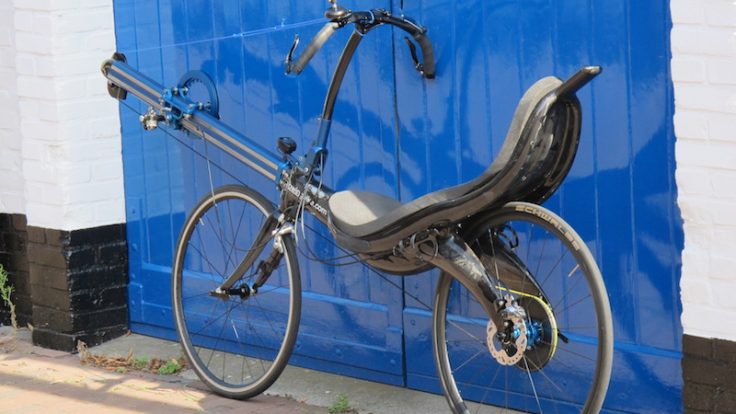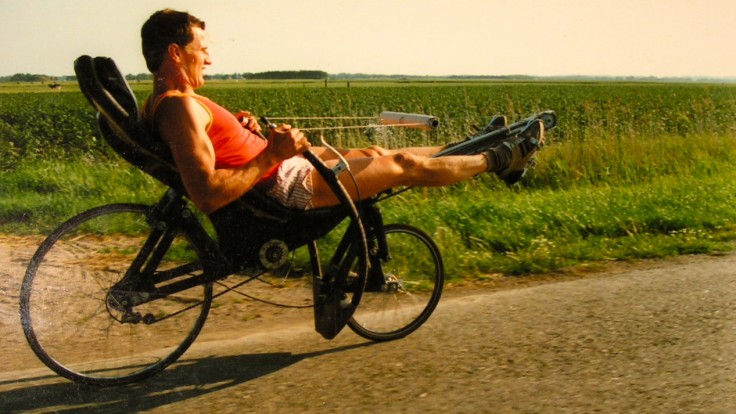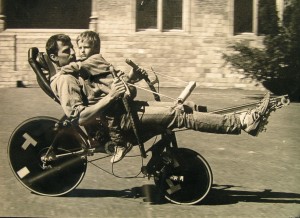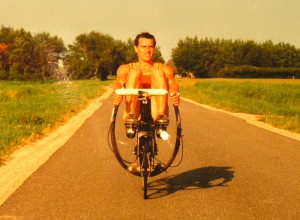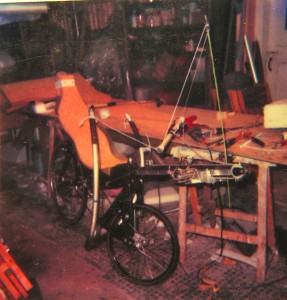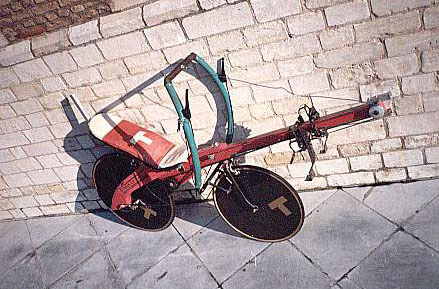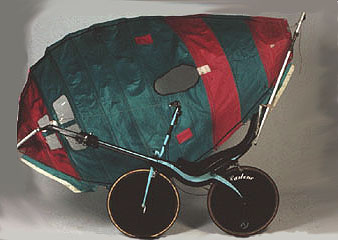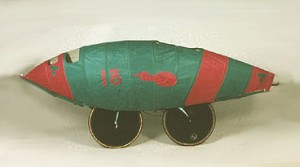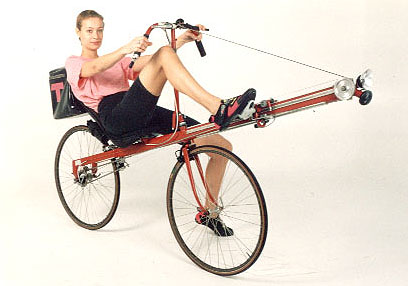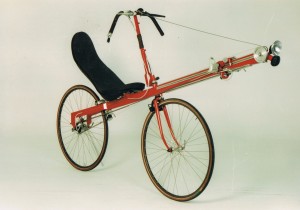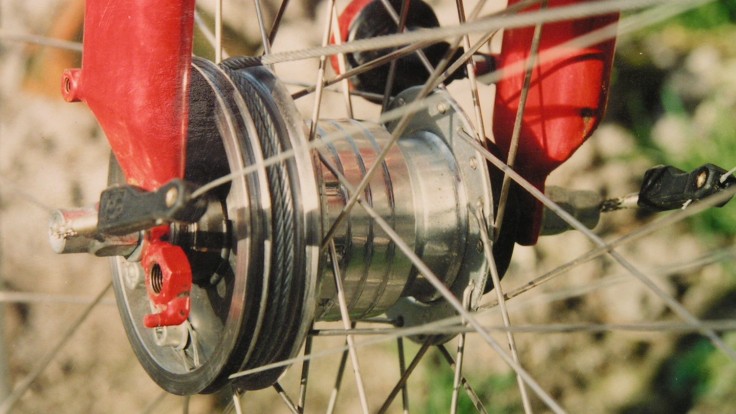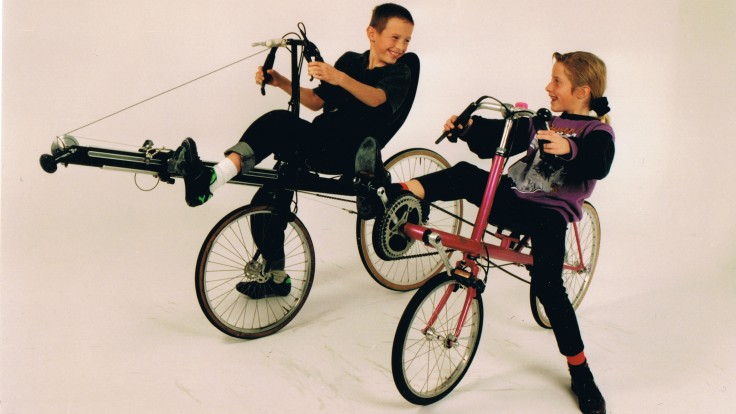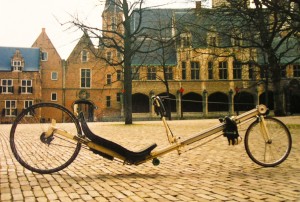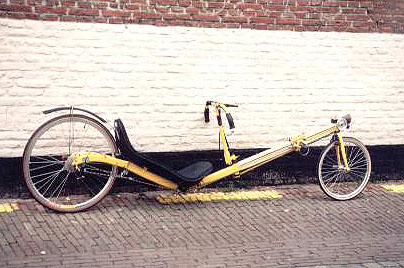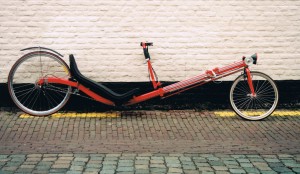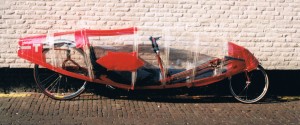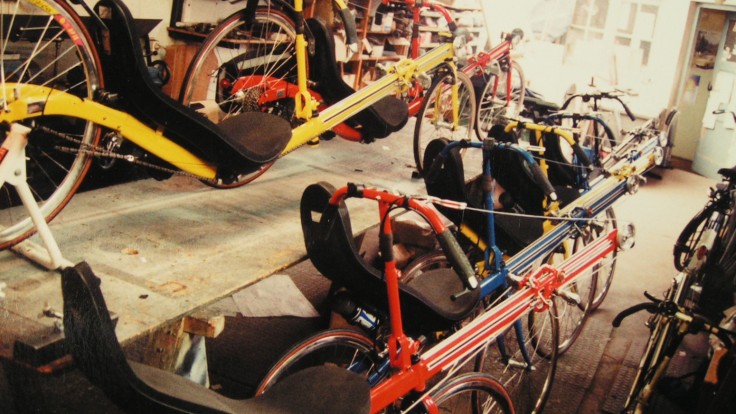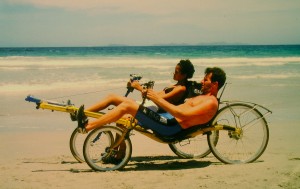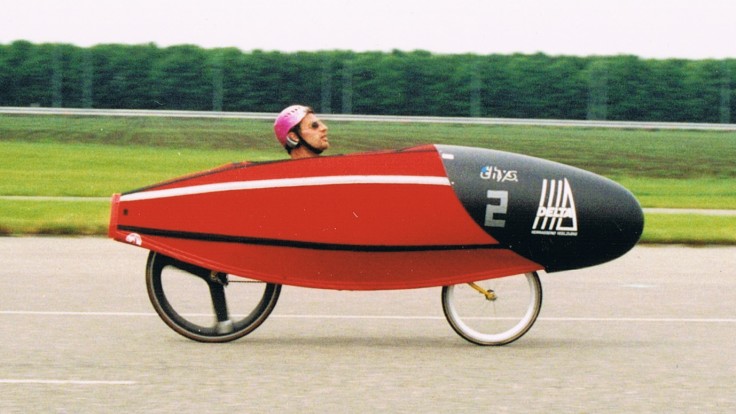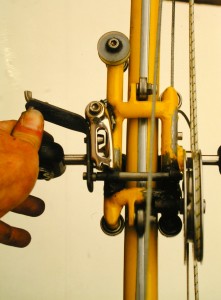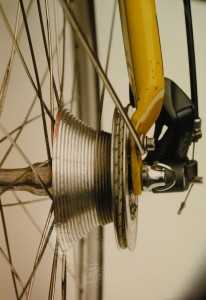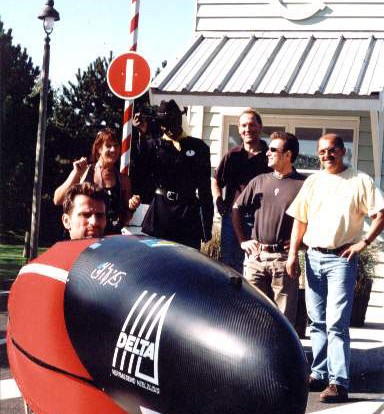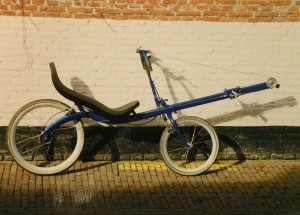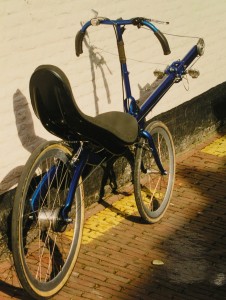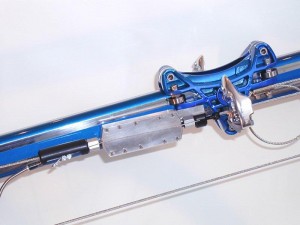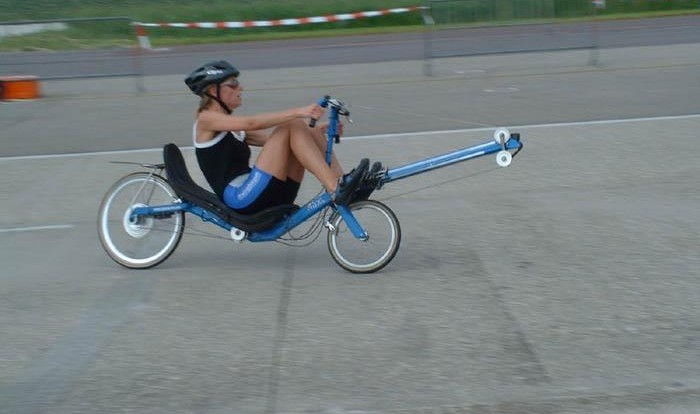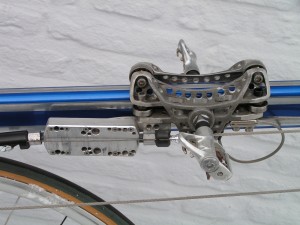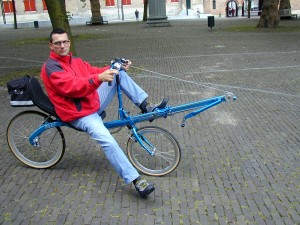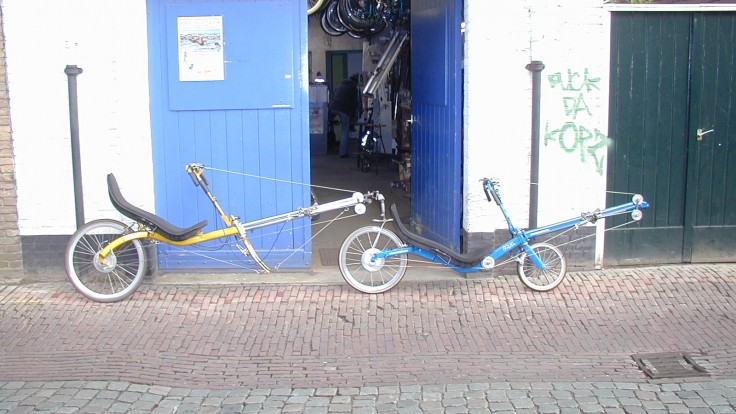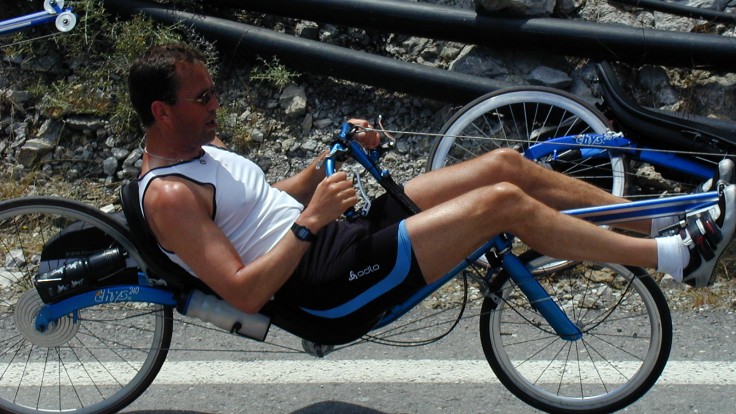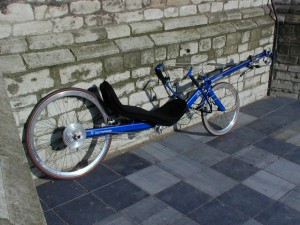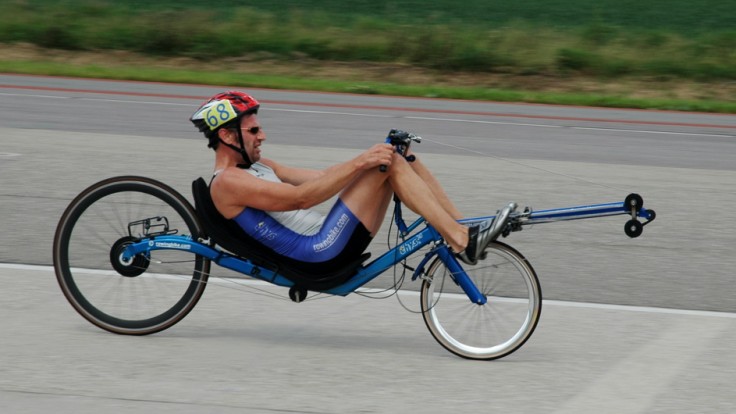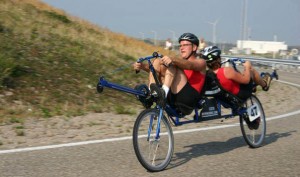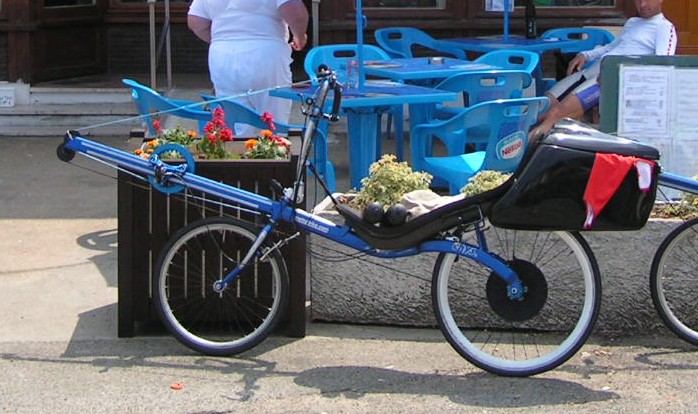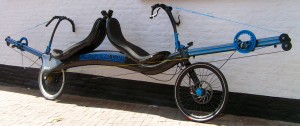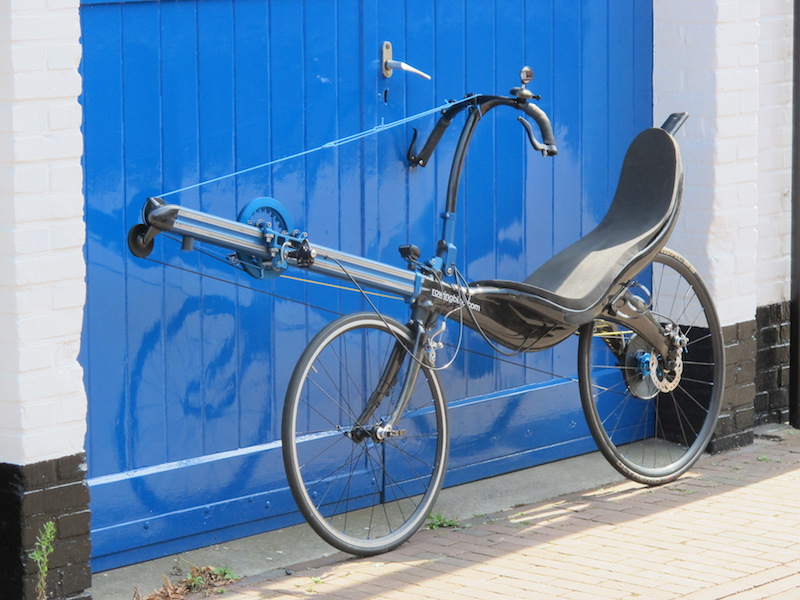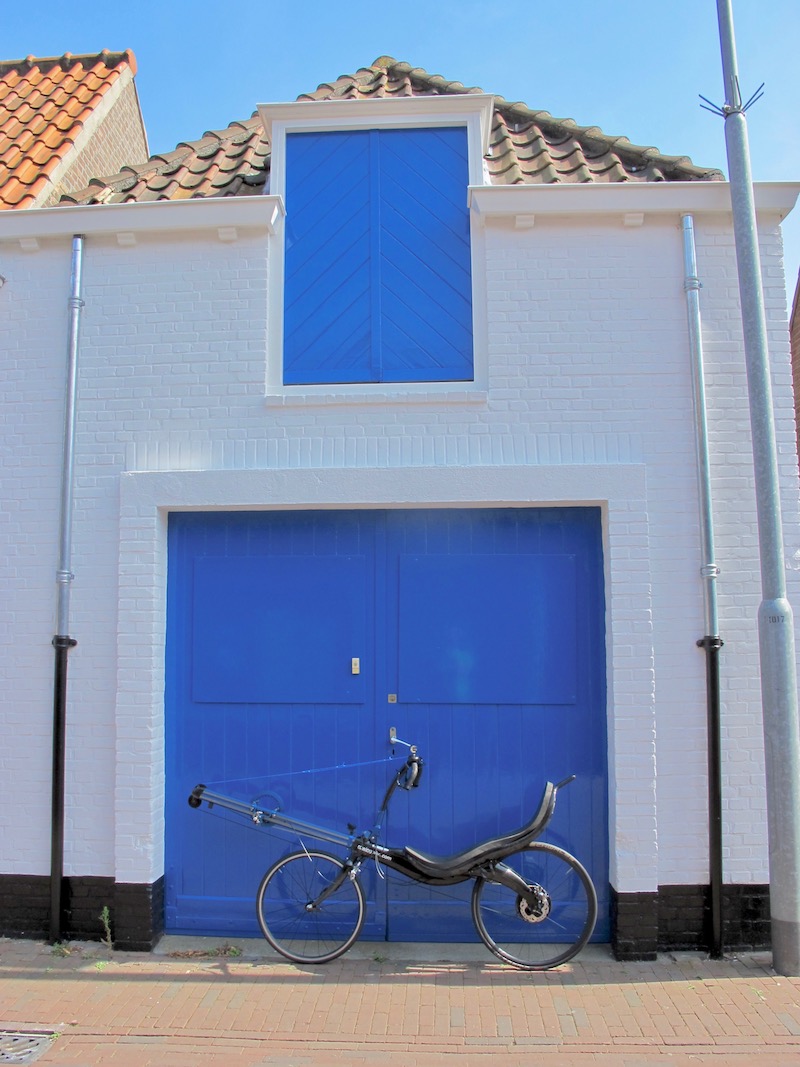The very first Thys Rowingbike was made out of carbon.
Precursors Rowingbike
- History Derk Thijs
- Other Designs
- Precursors Rowingbike
- Antique rowingbikes
- Colleagues
- Early THYS recumbent bikes
- Roger Gilmore's list
- Windsurfing
- Windsurfingrecords
1986
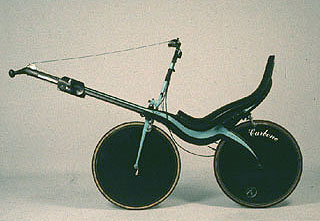
The third version
November 1988
Read moreIn the beginning this carbon bike had a 24” frontwheel and ”outboard” steering with 2 windsurfing boom rods.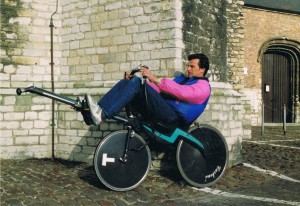
Later on a 28” front wheel was mounted and a steering bar with pivoting point just above the head set.
A sailcloth fairing made this a very fast rowingbike, it won the Tour de Sol in Zwitserland in 1989.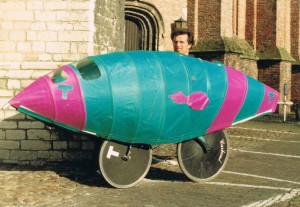

Fourth rowingbike: stainless steel
Read moreThis version was made from a stainless steel tube somewhere from the dismantling of a milk installation. It was round, I think a diameter of 45 mm with a wall thickness of just 1 mm. The bowsprit was a square stainless steel profile of 40 x 40 x 1.5 mm. Convenient that the ball bearings of the footslider could run directly along this profile.
After 5000 km the main tube broke off without prior notice. It was obviously too weak. After this the main tube was reinforced with a crosstree and after a while of faithful service the bike was sold to Olympic wind surfer Bart Verschoor. Unfortunately no pictures.
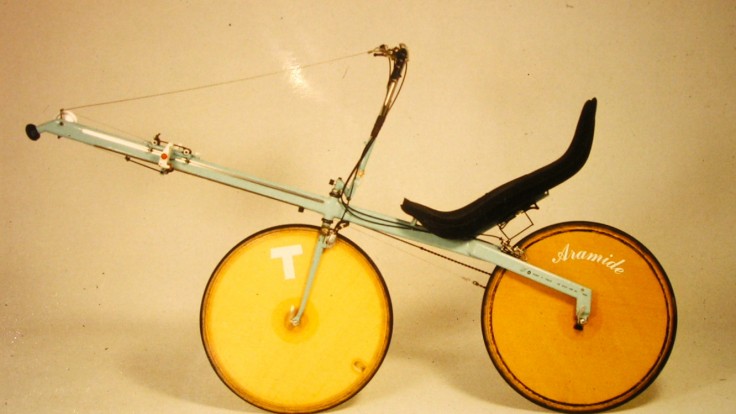
THYS 220 prototype in steel
Read moreFull carbon or kevlar wheels were used a lot at the end of the eighties. To cope with sidewinds the steering angle was made quite upright. That made this bike rather nervous. Nowadays rowingbikes have much more reclined steering angles which makes steering more stable and brings the front wheel more forward. With the center of gravity further behind and lower nowadays rowingbikes can brake much more aggressive than these older high rowingbikes.
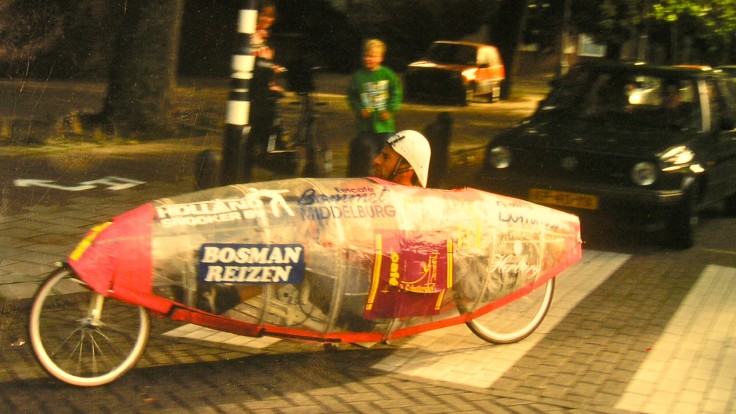
The low and long THYS 280 prototype
1993
Read moreWith this very low rowingbike, equipped with a fairing, Derk won the 1994 edition of the Paris-Amsterdam human power race. Technically this is a three-wheeled rowingbike, since there’s a skateboard wheel mounted on the lowest part of the bike to cope with speed bumps.
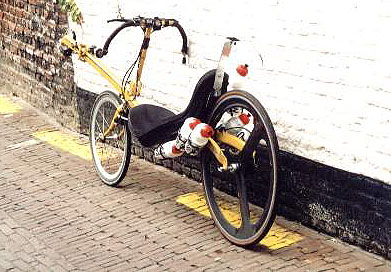
THYS 240, prototype
1997
Read moreIt is possible to add a fairing to this rowingbike. On the photo you can discern six water bottles of 0.75 litres each. According to Derk, this is not enough for a 6 hour race like the one on Cycle Vision in Lelystad, Netherlands. The Thys 240 is the precursor of the Thys 222, but was thought to be a little too extreme in terms of seat angle and height.
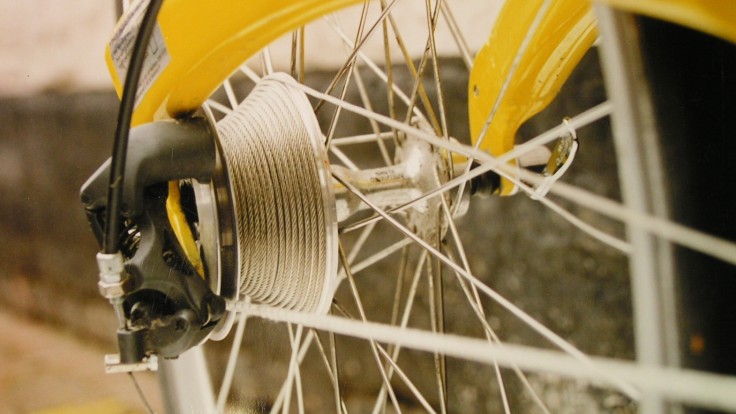
First versions of the snek transmission
1997 / 1998
Read moreThe concept of the Snek transmission was designed by brothers Bert and Derk Thijs around 1992. It took until 1997 before Derk bought his first lathe and he actually started to make prototypes. This very first Snek was made out of aluminium with a 2 mm wide groove (pitch 2 mm) for a 2 mm steel cable. This fist attempt was a primitive version of the current revolver system. Back then Derk found it hard to get the revolving principle working and it was not the only problem he had to cope with. As there were more problems, he started with what appeared to be the most simple shifting system, by derailleur. Derk says that, in retrospect, it was one of the most stupid mistakes he ever made. “I should have sticked with that revolving system”.
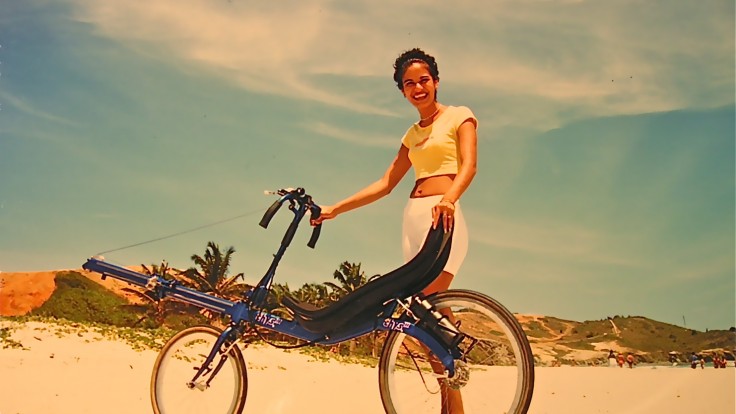
First prototype THYS 222
Read moreThe first 222 model was made in 1998 after the 240 model was thought of as a bit too extreme for the large public. Therefore a somewhat higher and less reclining model was designed. That was a good choice for a change! This model was the first of which the frame would be produced in Taiwan and in larger quantities. In fact it was the wish for (expensive) university studies of my children Sara and Derk that pushed me to make this large step to production series of 100 bikes in stead of just 10 or so per year that I could weld on my own. Thanks guys, for pushing me in the right direction. And for finishing your studies by now!
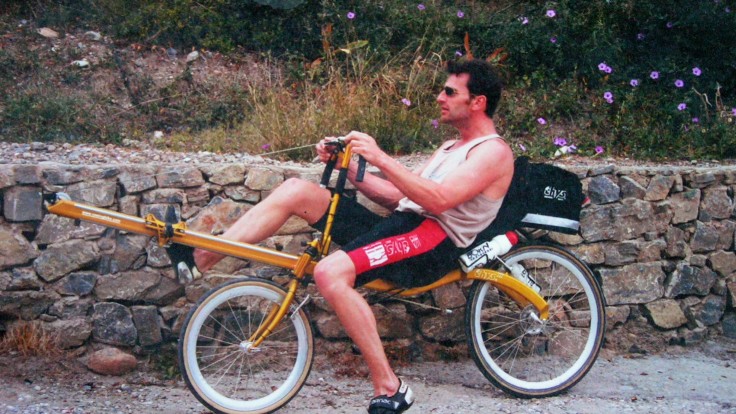
Gold nugget (Goudklompje), the first RR version
(Dutch) 2000
Read moreThis gold coloured 222 was the first prototype for the RR version. A lot of modifications were made on the standard 222 frame to hold the asymmetrical home-made rear wheel. The hub contained the roller ramp freewheel clutch that improved the catch (“inpik”) at the beginning of the stroke a lot.
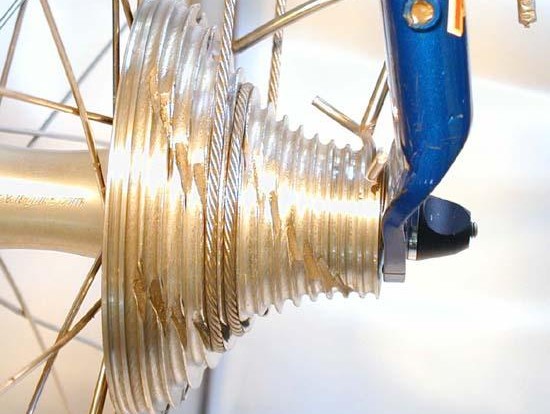
THYS 222 RR version
2001
Read moreThe RR version of the 222 has the THYS design rear hub with roller ramp freewheel clutch. This -very expensive- clutch ensures a direct grip on the rear wheel in the beginning of the stroke. The shifting system has improved but is not perfect. Diameter of the snek is limited to 120 mm. Only tall people can shift to the lowest gear while riding.

222 RR Tour de France version
2001
Read morePicture: Derk Thijs ascending the Alp d’ Huez
For the Rowingbike Tour de France an intermediate Snek was added to achieve the highly desired low gearing. However, this system shifted very poorly and it was never sold. It’s a small miracle the shifting system made it through the Tour de France, back in 2001. It did eat two steel propulsion cables a day on mountainous days :-)
The Rowingbike Tour de France was a turning point in several ways: it resulted in new technical developments and it encouraged quite some potential rowingbike riders to actually buy a rowingbike.

First CVT version on Gold nugget (Goudklompje)
Winter 2001/2002
Read moreAfter my Tour de France experiences with a very poorly working intermediate Snek it was clear to me that I had to principally change the gearing system. The CVT was a nice solution although the first version with the round shaped wedge housing jammed every now and than.

THYS 222 prototype with two 28 inch wheels
2003
Read moreSometimes tests of extremes can help you further. After the compact THYS 230 with 20 inch and 16 inch wheels it was interesting to know how two large wheels affect the speed and handling of the rowingbike. I suspected it to be fast and spend a lot of extra time on machining and drilling the footslider and the wedge housing of the CVT system. In the end, it turned out not to be fast and very unpractical.
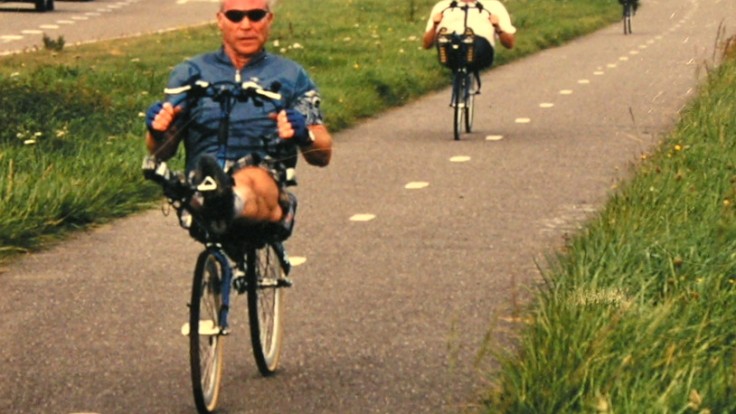
Special rowingbikes for use with one leg
Read moreIt turned out that the rowingbike is a great solution for people that can only use one leg. There are over a dozen rowingbike riders that only use one leg to propel the rowingbike. Starting off is hard to learn, but the effort pays off.
Since the rider also uses arm and back muscles, speeds are not much lower than when all four limbs are used. Nowadays each footslider already has extra attachment points for additional bearings. These are necessary to cope with the high asymmetrical forces these riders exert on the foot slider.
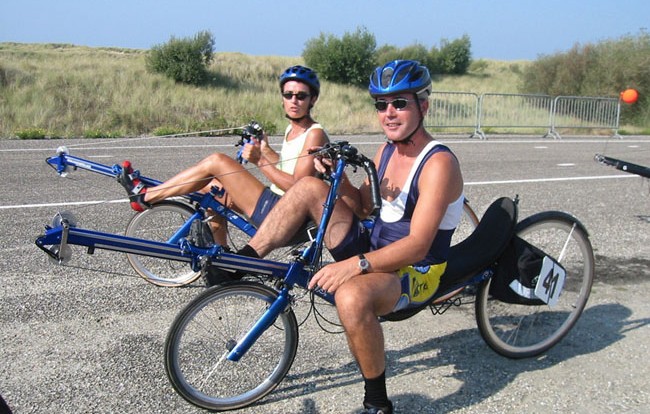
THYS 240 production model
Read moreThis picture below shows the improved second version of the wedge housing of the CVT system. On the first round shaped wedgehousing you sometimes needed a hammer to unlock the wedges :-(
All clients received this new wedge housing with needle bearings free of charge.
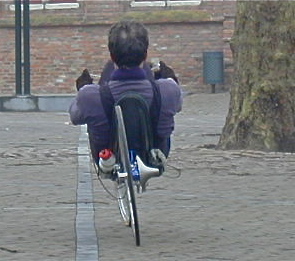
THYS 250 very low & long
2003
Read moreThe THYS 250 was an ongoing study for a follow-up model for the 222. After the THYS 245 prototype I tried to build a similar very low and fast rowingbike, but with the addition of an asymmetrical rear wheel. The frame tube was in the centre of the bike, the wheel on the left side of the tube and the Snek on the right side.
Large wheel bearings were placed in the frame tube. A very interesting experiment but not successful.
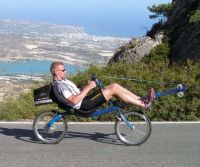
Thys 222 Revolver
2005
Read moreThe THYS 222 Revolver with 2 x 20 inch wheels. A precursor of the 220 mm snek was the 178 mm snek on a 20 inch rear wheel. A desirable gear for really steep slopes like Calibier and L’Alpe d’Huez.
The new revolver shifting system was developed winter 2004-2005 and thoroughly tested before introduction. Thanks to the revolver system and plastic sneks, Dyneema® cord can replace the heavy steel propulsion cable. It is a real thrill to see a 28 gram Dyneema® cord bringing the heaviest testrider (well exceeding 100 kg) up the steepest mountains.
Picture: Martijn Mateman on Crete
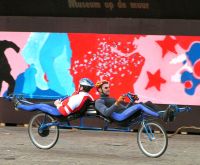
Tandem 2006 , Steel CrMo frame
2006
Read moreAfter the introduction of the revolver system there were no wishes left at the field of shifting mechanisms, it is a perfectly working system.
This gives opportunity to go to the next challenge: how to build a effective rowingbike tandem. This steel version already worked very good, but it turned out to have a few points that can be improved.

THYS 209 prototype aluminium
2007
Read moreAnother improved and lighter 209 prototype was made in 2007, weighing just 11 kg. Martijn Mateman confirmed the importance of weight during ascends. He improved his time to Males, Crete by 5 minutes, getting there in 40 minutes on a 5 kg lighter rowingbike.
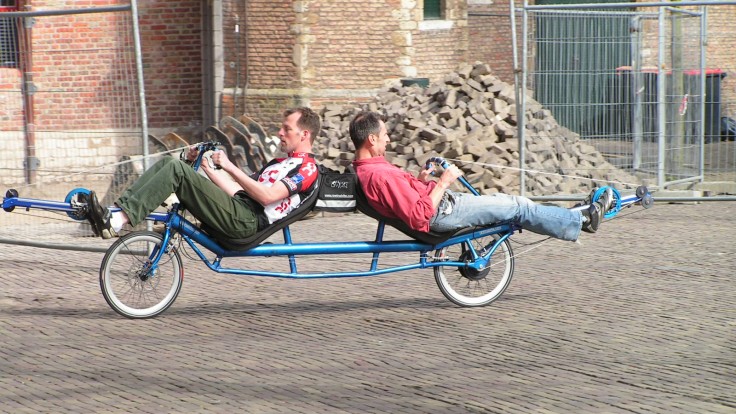
Aluminium Tandem
april 2007
Read moreIt is a low, light and fast tandem with two 20 inch wheels. Cables from the rear rider go straight to the left snek, without intermediate axle. The tandem performed really well on long distance tours and races. Long distance racer Theo Homan bought it and rode an extra 600 km within 24 hours, compared to another 24 hour race with Richard Bruijn and Derk Thijs.

Focussing on optimal carbon bike
2007
Read moreAfter the 209 prototypes it was clear how the follow-up for the 222 model should look like. It took a lot of time to find the right production company and to study their production process. Subsequently the 209 design was adapted to this production process to enable production and improve stiffness of several carbon parts.
First production samples came at Christmas 2009, series production started half a year later after thorough testing.
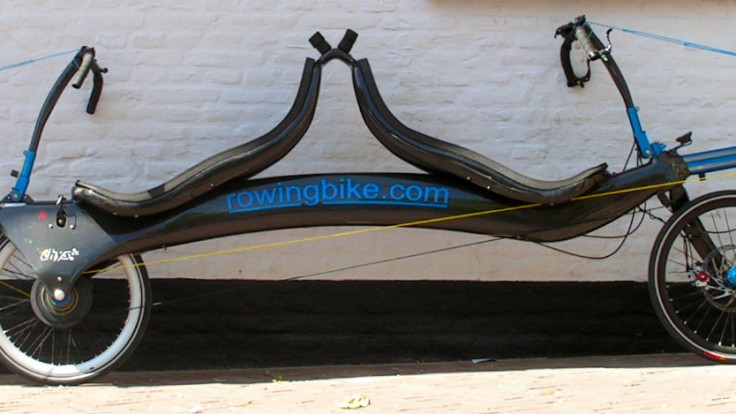
Carbon tandem
2008 / 2009
Read moreDuring the winter of 2008 /2009 the carbon tandem frame was designed the old fashioned way: take a piece of balsa wood and foam and shape it as you want it to be. It took more than a year to finish the moulds but it was worth all the work and waiting. In April 2010 the first carbon rowingbike tandem was finished and it is a great ride!!
